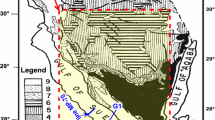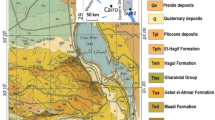Abstract
In this work, we present a reconnaissance study to elucidate and delineate subsurface fault structures for an active tectonics area that lies between Cairo and El Fayoum provinces and consider major sources of seismicity in Egypt. Well logging, aeromagnetic, land magnetic, and magnetotelluric data have been used. The well-logging data were used for several drilled wells along W–E direction. The magnetic data were analyzed using trend analysis, 3D magnetic modeling, and Werner deconvolution techniques. The magnetotelluric data were interpreted using 2D (TM–TE) modeling techniques. The results show that there are eight major fault structures having E–W, N–S, and NW–SE directions. These faults extend downward for about 20 km at the Dahshour and Qatrani areas. The epicenter sources of the earthquakes are clustering around the intersections of these structures. The Kattaniya horst structure has been interpreted as a regional structure that exceeds the limits previously determined by geologists. The depth to this horst reaches about 1.8 km at the NW and more than 4.3 km at the southern parts. The interpreted values of magnetic susceptibility at the horst zone indicate that they are ultrabasic/basic intrusion bodies.











Similar content being viewed by others
References
Abuelata AS (1990) The role of seismic-tectonics in establishing the structural foundation and saturation conditions of Elginidi basin, western Desert, Egypt (Egyptian Geophysical Society) EGS. In: Proceedings of the 8th annual meeting, pp 150–189
Attia OE, Lowenstein TK, Wali AMA (1995) Middle Miocene gypsum, Gulf of Suez; marine or nonmarine? J Sedimentary Res 65(4a):614–626
Badawy A (2001) The present-day stress field in Egypt. Ann Geophys 44(3):495–509
Badawy A (2005a) Seismicity of Egypt. Seismol Res Lett 76(2):149–160
Badawy A (2005b) Present-day seismicity, stress field and crustal deformation of Egypt. J Seismolog 9(3):267–276
Bedrosian PA, Unsworth MJ, Egbert GD (2002) Magnetotelluric imaging of the cree** segment of the San Andreas Fault near Hollister. Geophys Res Lett 29(11):1506–1511
Blakely RJ (1995) Potential theory in gravity and magnetic applications. Cambridge University Press, New York, p 441
Brimich L, Khalil A, Kordík P, Mekkawi M, El-Bohoty M, Refai MK, Khalaf A, Kader Abdel (2011) Active subsurface structures at Fayoum-Cairo district, Northern Western Desert, Egypt, as deduced from magnetic data. Contrib Geophys Geod 41(4):329–351
Egyptian General Petroleum Cooperation (1990) Aeromagnetic map for Dahshour–Qatrani area 1:100000
Egyptian Geological Survey (2003) Geologic map of Dahshour–Qatrani area with scale 1:500000
Elenean A et al (2010) Source parameters and ground motion of the Suez-Cairo shear zone earthquakes, Eastern Desert, Egypt. Nat Hazards 52:431–451
Encom Model Vision Pro (2004) Software for PC developed and supported by Encom Technology Pty Ltd. Version 6.00 Sep 2004: head office level 2, 118 Alfred St, Milsons Point, New South Wales, Australia 2061
Ghazala H (2001) Tectonic setting of the area between Cairo and Fayoum provinces, Western Desert, Egypt: implications of gravity models. In: Proceedings of 2nd the international symposium of Geophs Tanta University, Egypt, pp 101–110
Grant FS, West GF (1965) Interpretation theory in applied geophysics. MacGraw-Hill, New York, pp 584–588
Hammad MM, Awad SA, El Nady MM, Moussa DA (2010) The subsurface geology and source rocks characteristics of some jurassic and cretaceous sequences in the West Qarun Area, North Western Desert, Egypt. Energy Sources Part A 32:1885–1898. doi:10.1080/15567030701715955
Hussein HM (1999) Source process of the October 12, 1992 Cairo earthquake. Ann Geofis 42(4):647–665
Keeley ML, Massoud MS (1998) Tectonic controls on the petroleum geology of NE Africa, vol 132. Geological Society, Special Publications, London, pp 265–281
Ku CC, Sharp JA (1983) Werner deconvolution for automated magnetic interpretation and its refinement using Marquardt’s inverse modeling. Geophysics 48:754–774
Kusky TM, Ramadan TM, Hassaan MM, Gabr S (2011) Structural and tectonic evolution of El-Faiyum Depression, North Western Desert, Egypt based on analysis of landsat ETM and SRTM data. J Earth Sci 22(1):73–100
Kuss J, Scheibner C, Gietl R (2000) Carbonate platform to basin transition along an Upper Cretaceous to Lower Tertiary Syrian Arc uplift, Galala Plateaus, Eastern Desert, vol 5. Egypt–GeoArabia, Bahrain, pp 405–424
Linsser H (1967) Investigation of tectonics by gravity detailing. Geophys Prospect 15:407–434
Loutit TD, Allard JC, Dolson J, Schruers Laura S (2001) A new view of Egypt’s hydrocarbon potential (abs.): Middle East and North Africa (MENA)
Mahmoud SM (2003) Seismicity and GPS-derived crustal deformation in Egypt. J Geodyn 35(3):333–352
McClusky S, Reilinger S, Mahmoud SM, Ben SD, Tealeb A (2003) GPS constraints on Africa (Nubia) and Arabia plate motions. Geophys J Int 155:126–138
Meshref W, Abdel baki S, Abdel hady H, Soliman S (1980) Magnetic trend analysis in the northern Arabian Nubian Shield and its tectonic implications. Ann Geol Surv Egypt 10:939–953
Naeim G, Hussein A, El-Hakim B, Sewidan A (1993) A preliminary Report on the Dahshour earthquake, 12 October 1992. Egyptian Geological Survey, Intern report, pp 1–55
Pedersen LB, Rasmussen TM (1989) Inversion of magnetotelluric data: a non-linear least-squares approach. Geophys Prospect 37:669–695
Rabeh T, Ernst T (2009) Tectonic model of Egypt based on magnetic analysis. Acta Geophys 57(3):680–695. doi:10.2478/s11600-009-0013-x
Said R (1990) Cenozoic. In: Said R (ed) The geology of egypt, vol 1. A. A. Balkema Publishers, Rotterdam, pp 451–486
Sayed Ibrahim Selim El (2012) Subsurface structural trends of the Offshore Nile Delta area: evidences from gravity and magnetic data. Environ Earth Sci, Egypt. doi:10.1007/s12665-012-1804-y
Schnegg PA (1998) The magnetotelluric survey of the Penninic Alps of Valais, Bern, Swiss Geophysical Commission, p 76
Siripunvaraporn W, Egbert G (2000) An efficient data-subspace inversion method for 2-D magnetotelluric data. Geophysics 65:791–803
Soyer W, Unsworth M (2006) Deep electrical structure of the northern Cascadia subduction zone (British Columbia, Canada). Implic Role fluids Geol 34(15):53–56
Talwani M (1960) Rapid computation of gravitational and Ewing, M. attraction of three-dimensional bodies of arbitrary shape. Geophys 25:203–225
Unsworth M, Bedrosian P, Eisel M, Egbert GD, Siripunvaraporn W (2000) Along strike variations in the electrical structure of the San Andreas fault at Parkfield, California, in Geophys. Res Lett 200:3021–3024
Unsworth MJ, Jones AG, Wei W, Marquis G, Gokarn S, Spratt JE (2005) Crustal rheology of the Himalaya and Southern Tibet inferred from magnetotelluric data. Nature 438:78–81
Werner RT (1953) Interpretation of magnetic anomalies at sheet–like bodies, Sveriges Geol. Undersok, Ser., C. Arsbok V 6:413–449
Yungul EH (1996) Electrical methods in geophysical exploration of deep sedimentary basins. Printed in Great Britain by Edmundsbury Press, Bury St. Edmunds, p 207
Acknowledgments
The author also thanks the National Research Institute of Astronomy and Geophysics for providing the required data, facilities, and equipment for field work. We are also deeply appreciative to the Egyptian General Petroleum Cooperation for supplying us with aeromagnetic data.
Author information
Authors and Affiliations
Corresponding author
Rights and permissions
About this article
Cite this article
Rabeh, T. Delineation the active subsurface structures at Fayoum-Cairo district, Egypt, using magnetic and magnetotelluric tools. Environ Earth Sci 70, 1539–1550 (2013). https://doi.org/10.1007/s12665-013-2240-3
Received:
Accepted:
Published:
Issue Date:
DOI: https://doi.org/10.1007/s12665-013-2240-3




